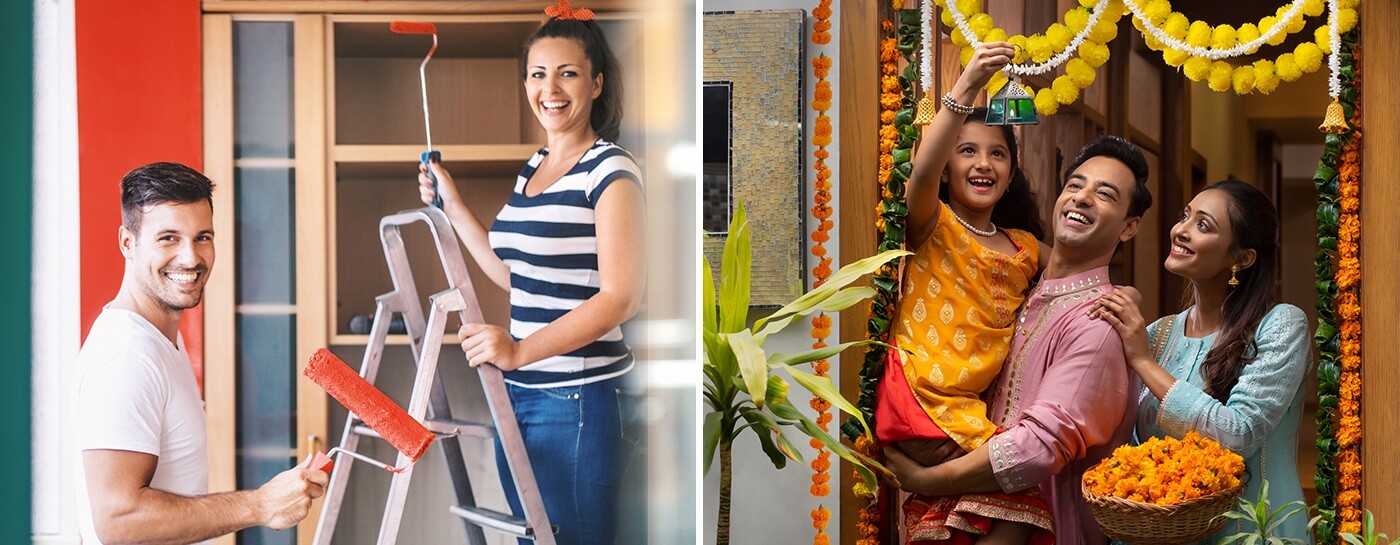Exploring the Timeless Indian Tradition of Painting Houses During Diwali
Painting houses during festivals is more than just an aesthetic choice. It is a way for people to express their cultural identity and is believed to bring good luck and prosperity to the household.
Diwali, also known as the "festival of lights", is one of the most popular festivals in India, making it one where homes across the country get a new splash of color.
In preparation for Diwali, people paint their homes in bright colors to welcome the goddess Lakshmi, who symbolizes wealth and prosperity. Families and neighbors work together to decorate and paint their homes, bringing a sense of community spirit and togetherness across the country. During the festival, people want their homes to look their best as they welcome family and guests, resulting in a high demand for quality paints and coatings to transform the appearance of homes. This surge in demand directly benefits the paint and coating industry, leading to increased sales and profits.
Consumers in India can access a wide range of products, including various colors, textures, and finishes, with manufacturers also investing in research and development to create innovative paints that provide durability, weather resistance, aesthetic appeal, and are environment friendly.
We list the various types of paints available in the market to inspire your home make-over this festive season:
- Oil Paint: Oil paint is a mixture of pigment particles and oil, typically linseed oil. It is used as a primer, undercoat, or finish coat. It offers durability along with a smooth, rich, and glossy finish. It is water-resistant and easy to clean. Suitable for doors, walls, and windows.
- Cement Paint: Cement paint is a comparatively costlier option but is more durable for homes with exposed surfaces and balconies that face changing weather conditions. Suitable for rough finishes and extreme weather conditions.
- White Cement Paint: This white paint is water-based and is used to preserve the texture and appearance of the surface that is being painted. When applied to porous surfaces like brick walls and wooden cabinetry, a whitewash finish could provide a rustic look. Suitable for ceilings, cabinets, furniture, and brick walls.
- Distemper Paint: Distemper is made from a mixture of lime, water, chalk, glue, and pigment. It is superior to a whitewash but less durable than cement paint. It is ideal for spaces where long-term durability is not a primary concern. Suitable for interior and exterior surfaces.
- Emulsion Paint: Emulsion paints (not to be confused with acrylic emulsion) display resistance to fungal and mildew, are simple to use, and come in a range of finishes. Emulsion paints are non-toxic, simple to clean, and should be considered for homes with children or pets. Suitable for exterior and interior walls, homes with kids and pets, kitchens where food is prepared.
- Enamel paint: Enamel paint offers outstanding durability and a variety of glossy effects. It dries slowly, is durable, and is stain and water-resistant. Although there are some water-based options, this paint is typically oil-based. Suitable for walls, surfaces made of metal and wood.
- Acrylic Emulsion Paint: The color brightness and gloss results are greater with acrylic emulsion paint since it has a denser consistency. This wall paint dries quickly, is water-resistant, non-flammable, odorless, and simple to clean. Suitable for wooden furniture and accessories, interior walls.
- Bituminous Paint: Bituminous paint serves a more practical purpose. It provides a shield of defence to surfaces since it is waterproof and resistant to rust and weather. However, it is not appropriate for locations with a lot of sunshine. Suitable for woodwork, pipes, grills, other metal objects, and underwater surfaces.
- Synthetic Rubber Paint: Synthetic resins, solvents, and color pigments are used to create this category of wall paint. It is considered a budget-friendly option for external walls and dries rapidly, providing good defence against the elements and toxins. Suitable for floors, bigger spaces, and concrete walls.
- Anti-Corrosion Paint: As the name suggests, this paint prevents corrosion on the treated surfaces. It is made from a combination of sand, linseed oil, and zinc chrome. Anti-corrosion paint is a durable and affordable choice for surfaces that are frequently exposed to air and humidity. Suitable for steel and iron-based metal surfaces, such as pipes and grills.
- Eco-friendly Alternatives: Eco-friendly paints, which are non-toxic and do not have harmful effects on our health and the environment, are becoming very popular in India as well. Three types of eco-friendly paints are available in India: Zero-VOC paints, Low-VOC paints, and Natural paints. Volatile Organic Compounds (VOCs) are a large group of chemicals found in paints that can affect the health of people or pets in the house, making zero- or low-VOC the preferred option. The total content of VOC in zero-VOC paints is nil to below 5 grams per liter of paint, while low-VOC paints can contain concentrations of 5 to 200 grams per liter of paint. Natural paints, on the other hand, do not contain any VOC and are formulated using natural compounds like tree resins, water, plant oil, essential oil, and natural dyes. They are available as water-based or oil-based paints. Suitable for interior and exterior walls.
At DKSH, our international teams of technical specialists collaborate across borders to develop innovative solutions for companies looking to tap into the growing paint and coating industry. Contact us to learn more about our products and capabilities to support your business growth.
Sources:


